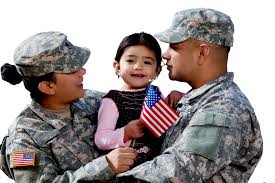


Children in Military Families
- Nearly 44% of active duty military members, and 43% of Reserve members, have children—an average of two children per military family. There are currently 1.2 million children of active duty military members worldwide. [1]
- Approximately 2 million children in military families have experienced a parent’s deployment since 2001. [2] During that time, 41,000 children have experienced a deployed service member parent being killed, wounded, injured, or seriously ill. [3]
- Military family moves may provide both positive and negative experiences for children, including increased family cohesiveness and resilience as well as stress and loneliness. [4]
[1] Clever, M., & Segal, D. (2013). The demographics of military children and families. Future of Children 23(2), 13–39.
[2] Ibid.
[3] U.S. Department of Defense. (2010). Report on the impact of deployment of members of the Armed Forces on their dependent children. Washington, DC: DoD. Retrieved from http://download.militaryonesource.mil/12038/MOS/Reports/Report-to-Congress-on-Impact-of-Deployment-on-Military-Children.pdf
[4] Weber, E. G., & Weber, D. K. (2005). Geographic relocation frequency, resilience, and military adolescent behavior. Military Medicine, 170(7), 638–642; Kelley, M. L., Finkel, L. B., & Ashby, J. (2009). Geographic mobility, family, and maternal variables associated with psychosocial adjustment of military children. Military Medicine, 168, 1019–1024; Marchant, K. H., & Medway, F. J. (2007). Adjustment and achievement associated with mobility in military families. Psychology in the Schools, 24, 289–294; all cited in Clever & Segal, op. cit.
Key Strategies for Inclusion
- Initiate contact. Identify military-connected children in the school and initiate contact with their families.
- Support successful transitions. Develop strategies to help military families move through key transition issues. Be flexible with meetings and events to accommodate military schedules.
- Facilitate educational continuity. Facilitate continuity in educational progress, records and placement by talking with children, parents, teachers and school administrators.
- Recognize sensitive issues. Provide guidelines for families and teachers to discuss issues related to military action.
- Advocate for military children and families. Consult the Interstate Compact on Educational Opportunity for Military Children.
PTA Resources
- Using the PTA National Standards for Family-School Partnerships to Support Military Families: 15 ways PTAs can support military families
- PTA Resolution: Educational Opportunity for Military Children
- Organizational Resources for Military Families: Lists organizations that support military families

